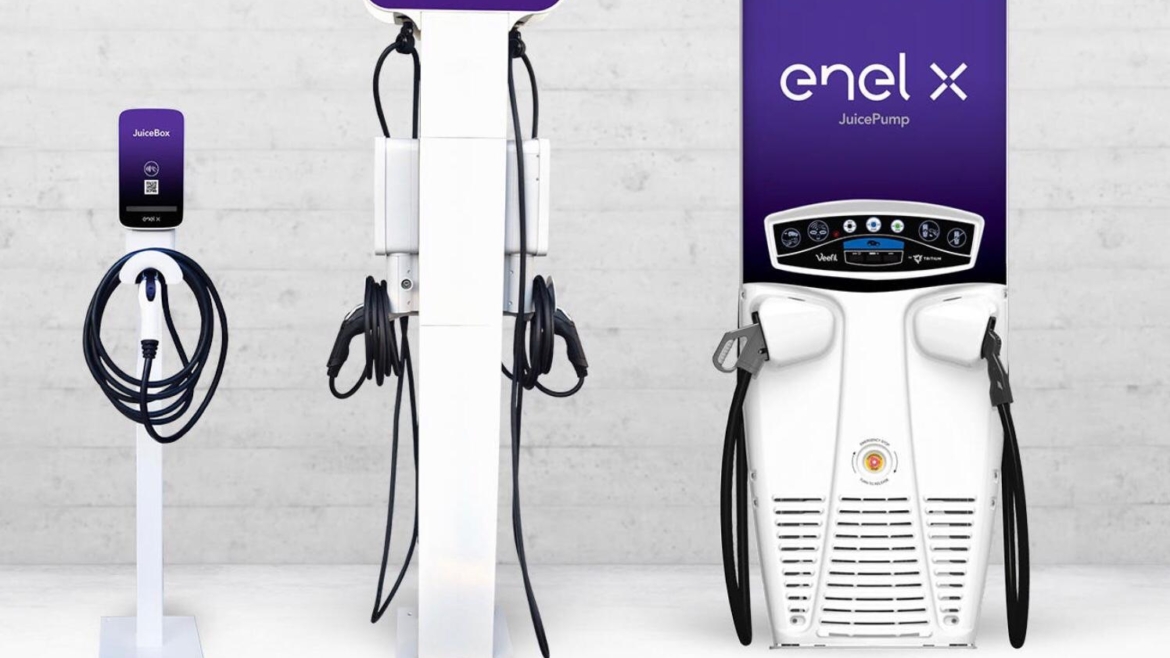An electric vehicle charging station, also called EV charging station, electric recharging point, charging point, charge point, electronic charging station (ECS), and electric vehicle supply equipment (EVSE), is an element in an infrastructure that supplies electric energy for the recharging of plug-in electric vehicles—including electric cars, neighborhood electric vehicles, and plug-in hybrids.
Some electric vehicles have converters onboard that plug into a standard electrical outlet or a high-capacity appliance outlet. Others use a charging station that provides electrical conversion, monitoring, or safety functionality. These stations can support faster charging at higher voltages and currents than residential EVSEs.
Charging stations provide a range of heavy-duty or special connectors that conform to the variety of standards. For common DC rapid charging, multi-standard chargers equipped with two or three of the Combined Charging System (CCS), CHAdeMO, and AC fast charging has become the de facto market standard in many regions.
Public charging stations are typically on-street facilities provided by electric utility companies or located at retail shopping centers, restaurants, and parking places. They can be operated by various private companies. Charging stations fall into four basic categories:
Residential charging stations: An EV owner plugs into a standard receptacle (such as NEMA connector in the US), recharging the vehicle overnight.[2] A home charging station usually has no user authentication, no separate metering, but may require wiring a dedicated circuit to have faster charging.[3] Some portable chargers can also be wall mounted as charging stations.
Charging while parked (including public charging stations) – a private or commercial venture for a fee or free, sometimes offered in partnership with the owners of the parking lot. This charging may be slow or high speed and often encourages EV owners to recharge their cars while they take advantage of nearby facilities.[4] It can include parking for an organization’s own employees, parking at shopping malls, small centers, and public transit stations.[5][6] Typically, AC Type1 / Type2 plugs are used.
Fast charging at public charging stations >40 kW, capable of delivering over 60-mile (97 km) of range in 10–30 minutes. These chargers may be at rest stops to allow for longer distance trips. They may also be used regularly by commuters in metropolitan areas, and for charging while parked for shorter or longer periods. Common examples are J1772, Type 2 connector, Combined charging system, CHAdeMO, and Tesla Superchargers.
The battery can charge in under 15 minutes. A specified target for CARB credits for a zero-emission vehicle is adding 200 miles (approx. 320 km) to its range in under 15 minutes. In 2014, this was not possible for charging electric vehicles, but it is achievable with EV battery swaps. It intends to match the refueling expectations of regular drivers and give crane mobile support for discharged vehicles where there is no charging station.
Methods of charging have changed and improved over time. New options have also been introduced on a small scale, including mobile charging stations and charging via inductive charging mats. Differing needs and solutions of various manufacturers delayed the emergence of standard charging methods, which is still an issue in 2015. The charging time depends on the battery capacity and charging power. In simple terms, the time rate of the charge depends on the charging level used, and the charging level depends on the voltage handling of the batteries and charger electronics in the car. The U.S.-based SAE International defines Level 1 (household 120V AC) as the slowest, Level 2 (upgraded household 240 VAC) in the middle and Level 3 (super charging, 480V DC or higher) as the fastest. Level 3 charge time can be as fast as 30 minutes for an 80% charge, although there has been serious industry competition about whose standard should be widely adopted. Charge time can be calculated using the formula: Charging Time [h] = Battery Capacity [kWh] / Charging Power [kW][8]
The usable battery capacity of a first-generation electric vehicle, such as the original Nissan Leaf, is about 20 kWh, giving it a range of about 100 mi (160 km). Tesla was the first company to introduce longer-range mass-production electric vehicles, initially releasing their Model S with battery capacities of 40 kWh, 60 kWh and 85 kWh, with the latter having an estimated range of about 480 km (300 mi). Plug-in hybrid vehicles have a capacity of roughly 3 to 20 kWh, for an electrical range of 20 to 80 kilometers (15 to 50 miles), but the gasoline engine ensures the full range of a conventional vehicle.
For standard charging (up to 7.4 kW), some vehicles have in-built chargers and can connect to the grid. For quicker charging (22 kW, even 43 kW and more), manufacturers have chosen two solutions:
Use the vehicle’s built-in charger, designed to charge from 3 to 43 kW at 230 V single-phase or 400 V three-phase.
Use an external charger, which converts AC current into DC current and charges the vehicle at 50 kW (e.g. Nissan Leaf) or more (e.g. 120-135 kW Tesla Model S).
Charging time for 100 km of BEV range[citation needed]
Power supply Power Voltage Max. current Charging time
Single phase 3.3 kW 230 V AC 16 A 5–6 hours
Single phase 7.4 kW 230 V AC 32 A 2-2½ hours
Three phase 11 kW 400 V AC 16 A 1½-2 hours
Three phase 22 kW 400 V AC 32 A 44–55 minutes
Three phase 43 kW 400 V AC 63 A 22–28 minutes
Direct current (DCFC) 50 kW 400–500 V DC 100–125 A 19–24 minutes
Direct current (DCFC) 120 kW 300–500 V DC 300–350 A 8–10 minutes
The user finds charging an electric vehicle as simple as connecting a normal electrical appliance; however to ensure that this operation takes place in complete safety, the charging system must perform several safety functions and dialogue with the vehicle during connection and charging.


